One love: Mama Ganache Artisan Chocolates are locally made for the good of the globe
By Hayley Thomas[{
"name": "Ad - Medium Rectangle CC01 - 300x250",
"id": "AdMediumRectangleCC01300x250",
"class": "inlineCenter",
"insertPoint": "8",
"component": "2963441",
"requiredCountToDisplay": "12"
},{
"name": "Ad - Medium Rectangle LC01 - 300x250",
"id": "AdMediumRectangleCC01300x250",
"class": "inlineCenter",
"insertPoint": "18",
"component": "2963441",
"requiredCountToDisplay": "22"
},{
"name": "Ad - Medium Rectangle LC09 - 300x250",
"id": "AdMediumRectangleLC09300x250",
"class": "inlineCenter",
"insertPoint": "28",
"component": "3252660",
"requiredCountToDisplay": "32"
}]
The story of Tom Neuhaus’ journey from young church organist to scientist to beloved Cal Poly professor to eco-conscious chocolatier is scrumptiously long-winded.
I met with Neuhaus at his Monterey Street chocolate production facility and boutique, Mama Ganache, on a chilly afternoon—and much to my joy—had a few delicious hours to spare.
Comforted by the sweet, luxurious scent of organic, fair-trade chocolate treats in the making, Neuhaus brought me back to Trier, Germany, 1945, where the chocolatier’s aunt and uncle lived. It was the end of the war, but just the beginning of their troubles.
“They had been bombed by the Americans and they lost all the wood in their house; all that was left was stone,” Neuhaus said. “They had nothing, living in the cellar. My grandparents, who lived in the United States, would send care packages of shoes, socks, and cigarettes.”
The cigarettes were used as currency, as the deutsche mark had become worthless. In return, Neuhaus’ aunt and uncle sent back German chocolates. Rich and velvety in texture, they soared far above the gritty American chocolate of the day.
“For years, every Christmas I got German chocolate, so I grew up not eating the crap sold in supermarkets,” Neuhaus said with a laugh. Now, Neuhaus recognizes making chocolate as an “applied science,” but back then, he just loved to eat it.
In 1961, when Neuhaus was 11 years old, his father, a renowned scientist, moved the family from North Dakota to France to pursue his mission of isolating a protein found in female rat urine (helpful to the study of kidney function). Neuhaus loved helping his father in the lab. Really, he loved anything where he could use his mind, creativity, and fingers in unison. When young Neuhaus wasn’t in the lab, he was immersed music. The boy relished playing pipe organ at his local church, and now—many decades later—still plays the organ at the Mission San Luis Obispo.
By the 1960s, Neuhaus had followed in his father’s footsteps to study science at Oberlin College. Halfway through his degree, he had a crisis of identity.
“I didn’t know why I was there,” Neuhaus said. “So, I typed out 25 letters on the typewriter, in French, and sent them to 25 French hotels, asking about becoming an apprentice. Three hotels responded. One said they’d take me on.”
This began Neuhaus’ long love affair with food. Although he was 17—and “too old” to be considered an apprentice by French terms—he was hired to work as an employee in the kitchen. After that, Neuhaus worked for a ski resort in the Swiss Alps, a fancy restaurant in Burgundy, and a bakery in Paris.
“Baking is so much about chemistry, and I was really getting into that aspect of it,” Neuhaus said, adding that it led him to land a job at a bakery in Vienna, Austria. After returning to Oberlin and receiving his bachelor’s degree in biology, he was distracted by food again. He worked as a chef in New York, eventually opening his first restaurant and bakery in Austin, Texas, with a partner he had met in Vienna. That eatery, Sweetish Hill, is no longer owned by Neuhaus, but is still considered an iconic Austin culinary establishment to this day.
It was at Sweetish Hill where the chef first toyed with the idea of purchasing ingredients directly from farmers—an idea that permeates his chocolate business, which utilizes fair-trade-certified cooperatives in Peru, Ecuador, and the Dominican Republic. Proceeds go toward Neuhaus’ nonprofit, Project Hope and Fairness, which benefits cacao famers in Ghana, Cameroon, and Côte D’Ivoire.
After working as a chef again in New York City and then on Capitol Hill in Washington, D.C., Neuhaus went back to college for his master’s degree: this time, for food science. Always looking to share his food findings, the chef wrote a culinary column in The Washington Post for seven years.
“I taught cooking and chemistry at Cornell University at the hotel school for 16 years, and that’s where I met my wife, Eve,” Neuhaus said. “Then, I got a job at Cal Poly, where I taught the anthropology of food, French speaking cooking classes, and culinary history for 17 years. It was the high point of my academic career.”
Finally, Neuhaus had combined his passions.
In 2000, Neuhaus started Cal Poly Chocolates, the only chocolate production course taught in American universities. He recently retired from Cal Poly, allowing him to focus even more on his passion, Mama Ganache. The chocolate-making idea first came in 2003.
“I was teaching this food anthropology class at the time, eating food, and bringing back my experiences for my students, and I decided to go to Africa,” Neuhaus said. “I got to know the people there and that got me started with the idea of supporting fair-trade farmers.”
Neuhaus began selling what he then called his “San Luis Fine Chocolates” at Mission San Luis Obispo, which he made at the Veterans Hall. The chocolate was delicious and the cause was close to his heart. The operation became a successful fundraiser for the cacao farmers he had befriended in Africa.
In fall 2004, the professor teamed up with his sister, Joanne Currie, to create a full-fledged chocolate business. Currie, who owns Splash Café in Pismo Beach alongside her husband, Ross, began selling her brother’s chocolates and baked goods. You may already know that these treats are now an iconic part of the Monterey Street Splash Café location.
The chocolate company eventually changed its name to “Sweet Earth” chocolates, and finally, to “Mama Ganache,” which Neuhaus said is an homage to the fact that “we all have mothers, and ganache is the mother of all chocolates.”
The Monterey Street location has been open since 2009, and includes a spacious production facility and adjacent warehouse packed to the gills with cacao beans and molds.
I toured the production facility, where chocolate bars, truffles, bark, creams, caramels, patties, cups, and coins are made for local and global enjoyment. Last fall, Neuhaus started his “bean to bar” program. These “World Chocolates” are made from beans that are hulled, roasted, and ground in a melanguer, which can be seen spinning in the window of the store around 3 p.m. every day.
Note: Don’t get caught up in the name: It’s basically a machine developed for making curry powder that doubles as a killer chocolate-making device.
Neuhaus begins by grinding cocoa butter and sugar for about a half hour. During that time, he roasts the broken nibs and breaks them down in a food processor. The beans are then slowly added to the melangeur.
During chocolate classes held each Saturday, Neuhaus shares where each bean is from, then hands out foil disks featuring beans from six countries, including Venezuela, Bolivia, Peru, Dominican Republic, and Uganda.
“We rate the chocolates by flavor attributes: chocolatiness, citrus, fruitiness, earthiness, roastiness, smokiness, and nuttiness,” he said. “It’s just like wine. With beans, it’s all about genetics and environment.”
Neuhaus continues to visit 21 villages in West Africa, taking any student or friend interested in making the journey. What he sees there is often harsh: child labor, poor working conditions, and unfair business practices. What he leaves behind are chocolate making factories, state-of-the-art technology, and—perhaps the most important thing—hope.
“I love bringing people to the village. We bring tools, drink the palm wine, and simply meet these amazing people,” Neuhaus said. “It’s like Gandhi said, ‘Be the change you want to see the world,’ or as Cal Poly says, ‘Learn by doing.’”
Hayley Thomas is inspired to do good and eat more good chocolate at [email protected].










